I’m not too proud to admit that I’ve had to walk a bike home with a completely preventable flat tire. I’ve learned since then about the importance of checking your tire pressure.
You should pump up your road bike tires at least once or twice a week, or before every ride if you don’t go out that often. Road bike tires have been known to lose pressure after 4-5 days of sitting still. I’ve been surprised with small leaks before, so I check mine before every long ride regardless of when my previous ride was.
Your tires should be somewhere between 80 and 130 psi. Here is a link to my post about how to pick the right tire pressure for you and your ride.
The pressure in your tires will naturally go down over time, whether they have tubes or are tubeless. Neither system is perfect, and they both slowly leak air. This makes sense because road bikes have very high pressures.
The higher the pressure, the more likely that the air will find a way to leak out. As well, road bike tires have a relatively small volume of air in them. So, even if only a little bit of air has leaked out, it means that a larger percentage of the total air is gone.
The temperature can also affect the pressure in your tires. For a given volume of air, the pressure will increase and decrease along with temperature. So, If you filled up to the right pressure in a cool garage, but you are out riding on piping hot pavement, expect the pressure in your tires to go up.
Thankfully, this doesn’t have a huge affect on the pressure. However, there have been occasions where people left their bikes baking in the hot sun, and their tires popped after getting too hot.
Riding your bike with the right tire pressure is very important. While tuning the pressure within a certain range will get you minimal returns, having a pressure outside of that range can actually cause damage. Riding with a low tire doesn’t just slow you down, it also wear out your tube and tire really fast. If your pressure gets low enough, you’re more likely to puncture the tube than you are to enjoy your ride.
Riding with a low tire doesn’t just slow you down, it also wear out your tube and tire really fast. If your pressure gets low enough, you’re more likely to puncture the tube than you are to enjoy your ride.
All of the different problems really just result in an increased amount of maintenance. You’ll need to buy more tubes, buy more tires, install them yourself, or go to a shop and pay someone to install them for you.
Investing in a cheap floor pump and using it regularly can pay for itself. Plus, taking more control over your tire pressure can result in a more enjoyable and safer ride! Click here to read a post about picking a good tire pressure for your road bike.
My suggestion is that you have a floor pump and you pump up your tires before every ride. Here is a link to check the price on Amazon. Make sure that you pick one with a pressure gauge. Getting it to the right pressure should be straight forward as long as you are paying attention.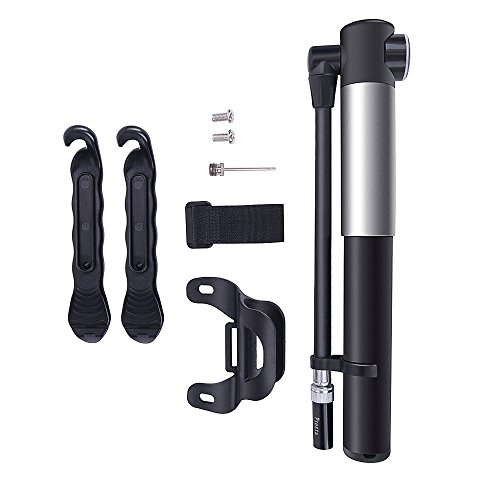
Just remember that you can pop a tire by pressurizing it too much. There are ways to check your pressure without pumping, though.
Compressing the tire, either by pressing hard with a finger or by sitting on the bike, is a fast and free way to check your pressure. It should compress very little under your finger, and a bit more when you sit on it. Not very much, but definitely some.
he ideal amount of “squish” derived by cycling scientists is 15% of the thickness of the tire. That’s hard to eyeball, though. As long as it gives a little bit, but not more than a few millimeters, then you should be okay.
The more official way to check the pressure without using a pump is to get an actual tire pressure gauge. Here’s a link to Amazon to see a few. You just press it onto the valve, and it will show you the pressure while not letting out much air. This is also much faster than setting up an entire pump.
I have a really easy digital one for my car, but I felt like getting one for my bike was more effort than it was worth based on how I get ready for rides.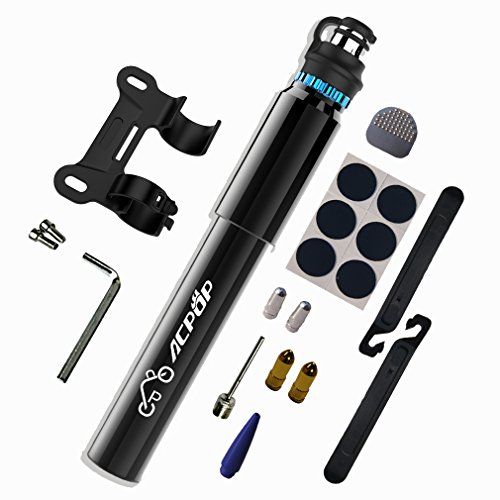
It just comes down to what your pre- and post-ride rituals look like, and how often you are actually checking the tires. I’d definitely have a gauge if I was checking tire pressures for more than a couple of bikes at once. That is way better than spending the time dealing with passing around one bike pump.
There are also miniature pumps that attach to your bike frame that you can use in if need to replace or inflate your tire while you are out on a ride. If you want one, this one on Amazon comes with a gauge and It has a ton of good reviews. So, I’m confident it’s actually useful and a good deal.
Going online, most people suggest checking your pressure before every ride. I agree. I’ve made it a part of my pre-ride ritual. Sure, it’ll add a minute or two depending on certain things, but it isn’t much. Besides, it can keep me from getting stranded 20 miles from home.
If checking before every ride isn’t your style, I’ve also seen it be suggested that you check one or two times a week. If you aren’t riding far, and you know when you last pumped up, you are pretty safe to just hop on your bike and go.
If you aren’t riding far, and you know when you last pumped up, you are pretty safe to just hop on your bike and go.
Taking the time over the weekend to refresh your tire pressure is also much more reasonable when you have to keep your bike in a shared space. I did this in college when I kept mine in the “bike room” and never ran into problems.
Outside of regular maintenance, here’s where I go over a short, non-exhaustive list of occasions when it would be a good idea to check your tire pressure.
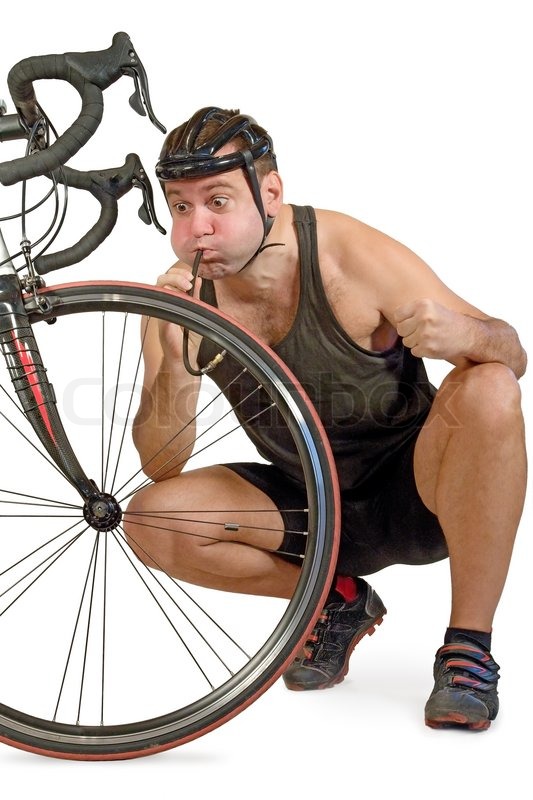
I hope that all of this has given you the confidence you needed to get on your bike without worrying about if you should have checked your tire pressure.
I make content that empowers people to enjoy riding their bikes.
Are you interested in learning more about that?
Here are some hand–picked posts that I think you might find helpful.
Riding and Training,Safety
Bike commuting a one-way distance of at most 10 miles is perfectly respectable. Much more and it can easily become a problem. You’ll need to take more …
Read More
Maintenance
You should always keep your road bike’s tires pressurized to be within the suggested range that is stamped on the side of the tires. Under-inflating …
Under-inflating …
Read More
Today I will tell you about a skill that every rider (cyclist or biker) should achieve. It’s about knowing how often to pump bike tires. Because if you don’t know how much air pressure your tires have, you can damage the bike if you go too fast. To determine the right time to pump your bike tires, you will need to know a few things, that we can name the rule of thumb. I have a good idea, let’s divide this into three parts. First, we will understand how pressure affects the bike ride. Second, we will know when it is safe to check the air pressure in your tires. And third, we will know how much air (correct tire pressure) it takes to fill the bike tire.
How often and how much tire pressure you need to pump your bike tires mostly depends on bike type and its tire size. If you want to make sure that your tire is inflated properly, then go ahead and check out my guide here. This article will help you learn when you need to pump bike tires.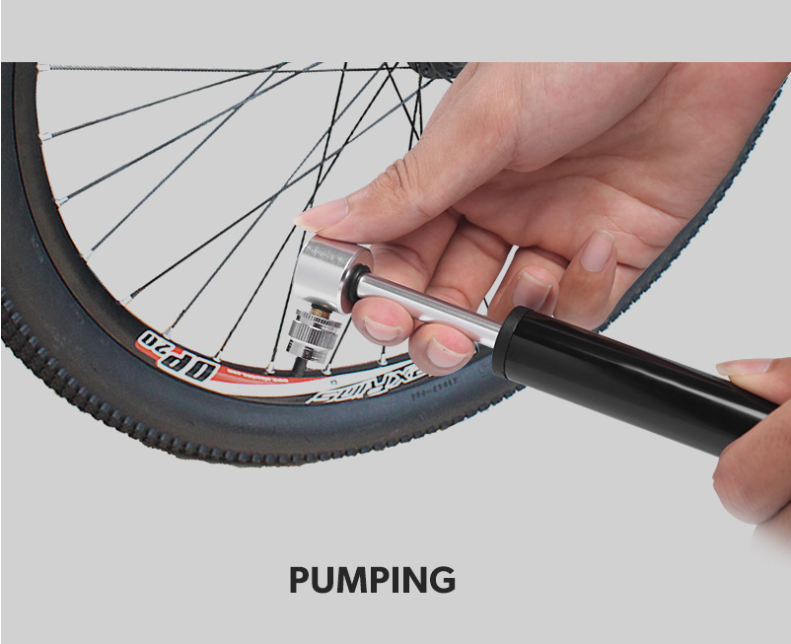
If it’s a road bike with high-pressure tires, you need to pump it at least once a week. If it’s a casual hybrid bike, And if it’s a knobby tire, mountain bike tires are a little wider so it’s fine to pump an mtb bike once in two or three weeks.
| Details | Road Bike | Hybrid Bike | Mountain Bike |
| Tire Width | 23-28 mm | 28-38 mm | 40+ mm |
| Avg Recommended Pressure Range | 100+ psi | 80-100 psi | 20 – 35 psi |
| Pressure Lost Per Week | 5 – 40 psi | 3 – 30 psi | 1 – 15 psi |
| How Often To Check The Pressure | Every Few Days ( At Least Once a Week) | Every Two Weeks | Every Three-Four Weeks |
When we are using a high-pressure road bike, we need to pump our road bikes at least once a week so the air pressure will be at maximum.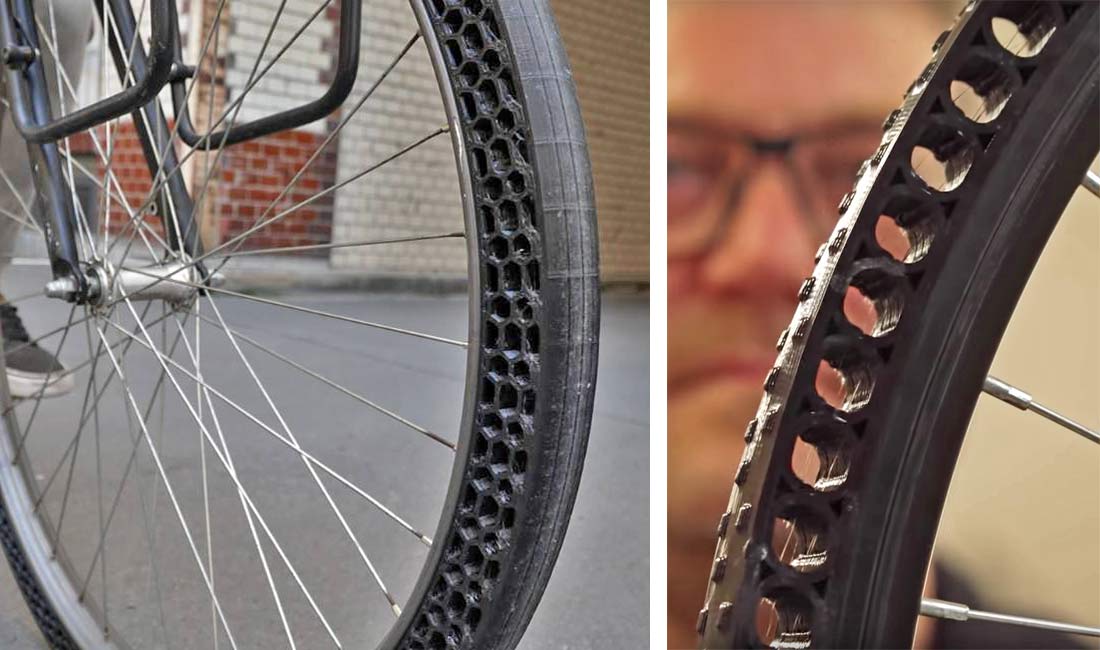 And we don’t want to be found on a bike ride half on a flat tire on the road and offroad. So remember to check and pump your road bike tires within a week after you started riding. But when our bike changes, we are commuting with our casual hybrid bikes, the tires need to be pumped at once every two weeks. And when it’s an MTB bike with knobby tires sometimes it’s fine to wait for several days like two-three weeks.
And we don’t want to be found on a bike ride half on a flat tire on the road and offroad. So remember to check and pump your road bike tires within a week after you started riding. But when our bike changes, we are commuting with our casual hybrid bikes, the tires need to be pumped at once every two weeks. And when it’s an MTB bike with knobby tires sometimes it’s fine to wait for several days like two-three weeks.
Because while riding on the road bike at full speed its tire is gonna lose air faster than other two types of bikes tires. As we know faster speed and narrower tires mean faster wear and tear and more air pressure loss.
Air pressure in mtb tires and hybrid tires are usually lower than on the other two types of bikes. So, it can be neglected a bit and wait for several days or so to fill the tire with air. It’s recommended to check the mtb bike for 100 psi and then go with a bike pump. And if you are a heavier rider then you should check it frequently.
No matter if you are riding a road bike, hybrid or commuter bike, or mtb bike, you should keep checking the bike tire at the mentioned time. If you have a pressure gauge floor pump (actual tire pressure gauge), getting the accurate pressure in number is quite easy. Try it and know the score to pump at the right time with the right amount which is essential. If you put high pressure on the bikes, it will rather slow you down. The tire will be hard to ride and will vibrate and bounce. It will increase the rolling resistance and will give you a harsh ride and will take more effort to traction, it is time for a new air pump and some high-pressure bicycle tire inflation for a comfortable ride.
If you have a pressure gauge floor pump (actual tire pressure gauge), getting the accurate pressure in number is quite easy. Try it and know the score to pump at the right time with the right amount which is essential. If you put high pressure on the bikes, it will rather slow you down. The tire will be hard to ride and will vibrate and bounce. It will increase the rolling resistance and will give you a harsh ride and will take more effort to traction, it is time for a new air pump and some high-pressure bicycle tire inflation for a comfortable ride.
After every ride – of course, you should regularly check the pressure of both front and rear tires when you ride a road bike. Sometimes, it is okay not to check the air pressure immediately after every ride if it’s a commuting bike or mtb bike. Mtb bike has a wider tire that can run longer
We should check bike tire pressure and update it in order to maintain the road bike tires’ optimal performance. if you are worried about the pump, don’t be.
if you are worried about the pump, don’t be.
There are many types of bike pumps available in the market. Rather than visiting a gas station regularly, you can buy any of the best bike pump ( a mini pump, or a bike mount pump) to save some money. If you are searching for a good option that is affordable, a floor pump can be the best choice. Pumping isn’t a difficult task, open the valve cap, place the pump head ( bicycle pump or any of the mentioned pump) you have on the bike tire valves, pull up the lever, and inflate the tire properly. Now remove the pump from the tire valve and that’s it!
But make sure you track the pump bike tire pressure while pumping.
In addition to checking tire pressures, also pay attention if there are any cracks or tears on a bicycle wheel or Presta valve because it can leak air easily. If there are any noticeable cracks or tears in the tire sidewall, Presta valve, schrader valve or valve core, this is recommended to be repaired right away and not wait for unnecessary failures which can occur if you don’t do so as soon as possible.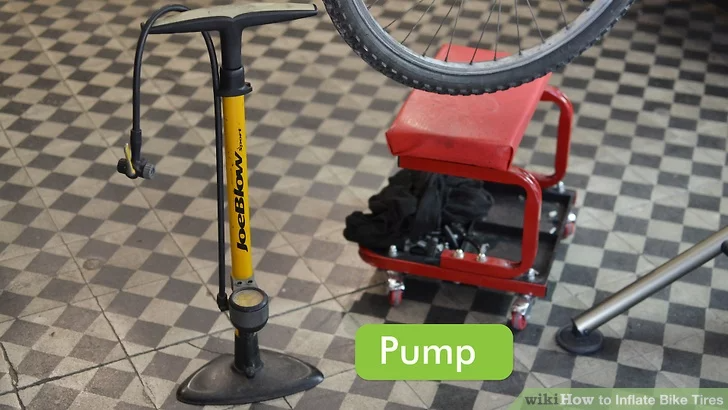
Properly inflated tires mean no punctured tire and a smooth ride. Like car tires or trucks, bike tires will rapidly wear out with even moderate to light rides. Actually, that’s all the more reason why it is so important for you to keep those rubber blocks in good shape! With a little bit of routine bike maintenance and regular checks and adjustments over time — you can extend the life of your tires by quite some time.
While riding a bike, a tire’s inflation pressure is an important element in how a bike will ride. In fact, the air pressure in your tires affects not just how smoothly it rides but also tire life. If the bike has lower tire pressure than the right range, it’s gonna cause damage to the tire and ruin the fun of your ride. Higher pressure creates firmer and stiffer rides on bumps. It also eliminates tire sidewall wobble, which can help improve ride comfort by reducing vibrations and allowing better handling for a long time. So having a properly inflated tire is important for every type of bike.
So having a properly inflated tire is important for every type of bike.
Whether you have an inner tube or are a tubeless bike tire, the total air pressure of the tires will go slow, puncture naturally, or will pinch flats. Because tubeless tire and inner tube tires both systems tires will leak air slowly. If it’s high-tire pressure road bike tires you will face air leaks faster than ever. While with a commuter bike or a mtb bike, it doesn’t happen. Mtb tires take a minimum of 2-3 weeks to leak air.
Let’s know the fine details of different tire pressure rating (Psi range). Road bike tires usually need maximum pressure of 100psi, a hybrid bike 75 psi, and an mtb bike 65 psi.
The following amounts are the proper tire pressure levels for these bike tires. If it goes lower than these, you need to pump the tires immediately.
Most of us don’t know temperature also affects the pressure in our tires. If the tire is filled with correct tire pressure in a cool garage but not on the ride over hot pavement the pressure will go up.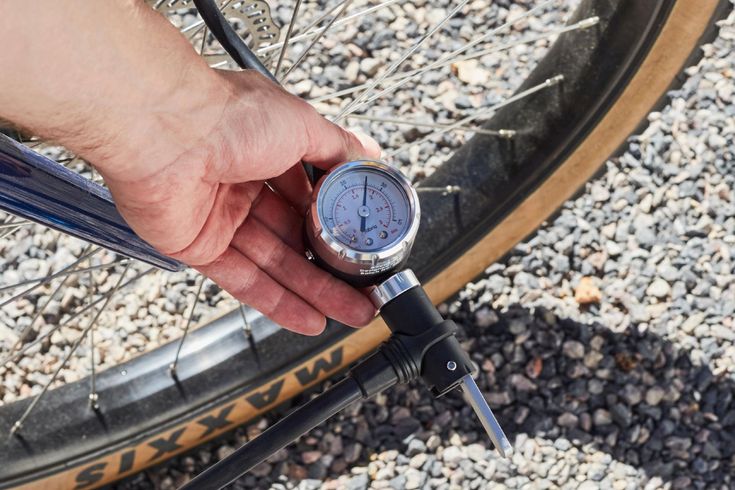
For a given volume of air, the pressure tires will increase and decrease along with the temperature. So, If you filled up to the right pressure in a cool garage, but you are out riding on piping hot pavement, expect the pressure in your tires to go up. And if you leave your tire under the hot sun, chances are there it can pop up due to getting overheated.
How Much Air To Put In Your Bike Tire Photo Credit: IstockphotoThis can get tricky since all bikes are different. A road bike will blow through a single ride tube or two. A mountain bike tire will blow them away in due time. Usually, if you have a road tire that is much bigger than usual, it will hold pressure longer and will offer you a long ride.
If we take for a standard example 50 x 1.75 road tires and 35 x 2 mountain tires – how many pumps would be needed? Well, here is the formula: For p = number of air pumps. For r = road rim size. And for v = volume of a rotational revolution on a tire
Then we can get this simple conclusion that you need to inflate two road tires with 1 psi each in 120 pumps and one mountain bike tire with 2 psi in 80 pumps.
If you are not much of a maths person – we always recommend that the professionals fill up each tire to the maximum which is approximately 1 bar. If you have already done your research, then great! Just add them all together and you will have a rough estimate of how many pumps you need for ONE bicycle tire.
Tips
These are main bike tire pressure tips from us that might help to avoid buying extra items:
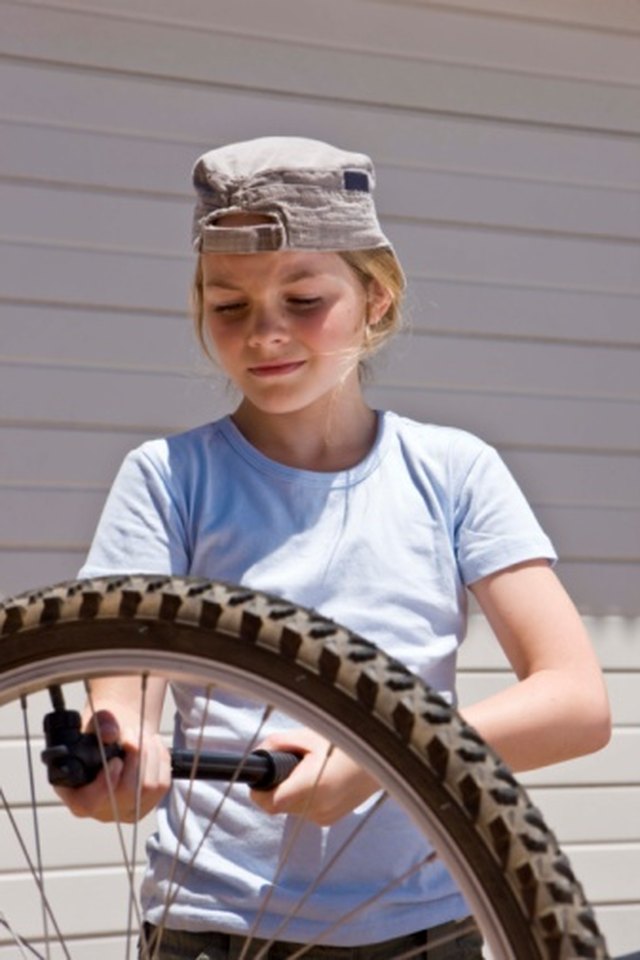
Conclusion
Whether it’s your road bike or mountain bike, you’ll need to pump the tires regularly. But only then when they need. To keep them in top shape, it’s important to maintain the air pressure in the tires. But not more than their need. Over-pumping can damage the tire and make it less durable over time. But how often should you pump? I have given the answer above. I hope now you are clear about when you should pump your bike, in which amount, and why.
FAQIs it normal for bike tires to lose air?Yes, it’s normal for bike tires to lose air. But if the amount of air lost is more than a bike should lose then it’s not normal. If your bike is a road bike and it’s losing air 5-40 psi, or a hybrid bike that is losing 3-30 psi, an mtb bike losing 1-15 psi per week then it’s normal.
How often do you need to add air to tires?If it’s a road bike with high-pressure tires, you need to pump it at least once a week.
If it’s a casual hybrid bike you need to pump it once every two weeks.
And if it’s a knobby tire mountain bike tires are a little wider so it’s fine to pump an mtb bike once in two or three weeks.
Why do road bike tires lose air so fast?If you ride a road bike, your tires will lose air quickly due to the speed of the bike. The tire loses air because of how fast it is spinning, which is why we use tubes in the tire to give it more time to slowly deflate without losing its shape and becoming unsafe for us to ride.
What happens if I Over inflate my bike tires?If you overinflate your bike tires, the air will push out from under the tire and can cause it to burst. This happens because there is not enough pressure in the tire and if it bursts, you could lose control of your bike.
Can a tire go flat for no reason?No, a tire can’t go flat for no reason. There are many factors that can cause the air to escape from the tire, such as punctures or cuts in the rubber.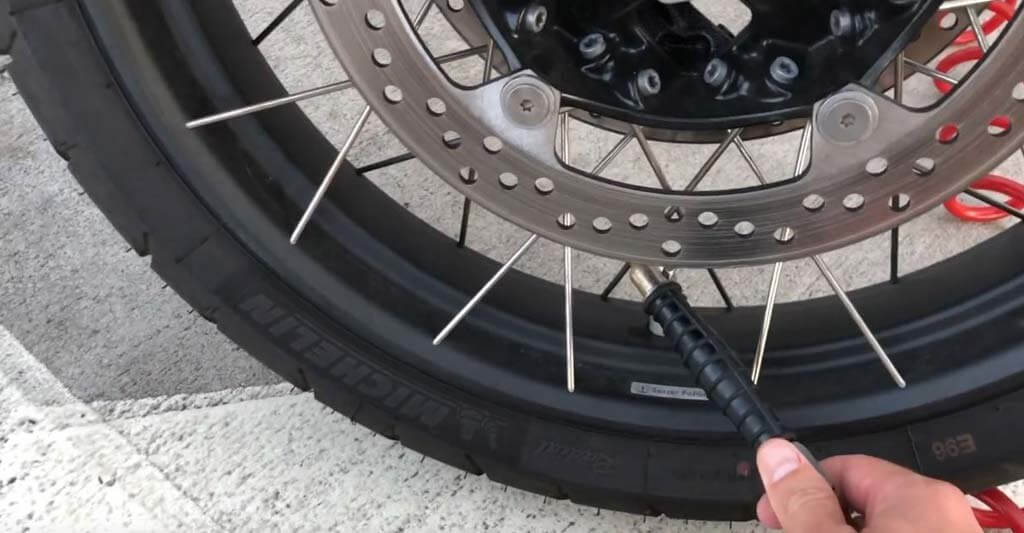 However, these types of flats happen in the most simple situations.
However, these types of flats happen in the most simple situations.
Disclosure: This site is a participant in the Amazon Associates Program. As an Amazon Associate, I Earn From Qualifying Purchases.
When buying a bicycle for themselves, many do not even think about the fact that the convenience and comfort when riding it is achieved by properly selected tire pressure. The service life of the bicycle, the speed of riding, the degree of tire wear, safety, control of the two-wheeled friend depends on how the wheels are inflated.
Many cyclists believe that inflating the tires is only necessary for a good bike ride. However, flat tires have a wider area of contact with the road, which means that grip will be better, but it will be very difficult to accelerate to a speed of 30-35 km / h on such tires.
When inflating your tires, you should always consider the type of terrain or surface you will be driving on. If the walk is supposed to be on an asphalt road, the tire pressure of the bicycle should be close to the maximum allowable value. Elastic wheels on a flat surface will provide a smooth rolling and high speed of movement.
For cross-country riding with unpaved paths, it is better to set the tire pressure to medium tolerable, so that you can ride long distances in comfort and convenience. At high pressure, the grip of the wheel with the road will be minimal, respectively, all holes, pebbles, and bumps on the road will be sensitive.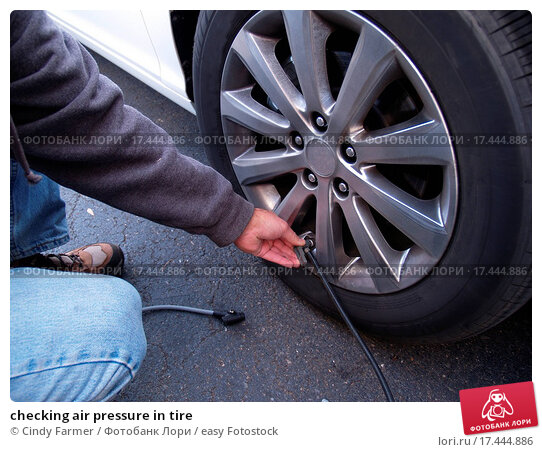 And with flat tires, the likelihood of damage to the wheel or puncture of the chamber increases.
And with flat tires, the likelihood of damage to the wheel or puncture of the chamber increases.
In order to protect yourself on the road, as well as to keep the bike or its individual parts intact, you need to know exactly the lower and upper limits of permissible values, to what pressure the bicycle wheels can be pumped.
Information about tire pressure gives you an advantage when cycling:
Forget the old "grandfather" way to check the wheel with finger pressure. No need to rely on tactile sensations, trying to feel with your hand the degree of rubber penetration on the tire. The air leaves the wheel gradually, through the pores in the rubber. Within 2-3 weeks, the pressure decreases by 0.1-0.2 atmospheres, but you cannot determine this with your fingers. The exact value at any time will help determine the pressure gauge that every cyclist should have in his arsenal. With its help, it is simple, with a minimum error, the level of pressure in bicycle tires is measured. A pump with a pressure gauge (floor or manual) will become an indispensable tool for cyclists.
There are three standard values in which bicycle tire pressure is measured.
kPa = 14.504 PSI
All these units are used to some extent - in different countries, by different manufacturers. For residents of Russia and the post-Soviet space, the change in bars is more familiar, since this unit is clearly associated with the pressure of the 1st Earth's atmosphere at ocean level. In America and Western Europe, a popular unit is PSI, as they actively use pounds and inches in measurements. Pascals are the least used unit of measurement, but the most modern. Some bicycle manufacturers write data on the wheels about the allowable pressures in all three systems.
In America and Western Europe, a popular unit is PSI, as they actively use pounds and inches in measurements. Pascals are the least used unit of measurement, but the most modern. Some bicycle manufacturers write data on the wheels about the allowable pressures in all three systems.
Manufacturers indicate on the sidewall of the tire how many atmospheres to pump the bicycle wheels. Specifies the range within which the owner of the "iron horse" determines the desired values, depending on the specific factors of riding his bike. Values in the range are labeled from min to max, in two or all three dimensions. Numbers up to 10 are atmospheres (or BAR), tens-hundreds are PSI, and six-digit values \u200b\u200band with the prefix “k” / kilo are Pascals.
When inflating a tire, you must strictly follow the manufacturer's recommendations and try not to go beyond both the minimum and maximum pressure levels indicated on the tire. Moreover, it is better to leave a small margin of 0. 2-0.5 BAR, both in one direction and in the other, so that the tire does not burst.
2-0.5 BAR, both in one direction and in the other, so that the tire does not burst.
The pressure in the wheel is kept by the tire, not the tube, so there is no single standard for its value. There are several significant factors that determine how much you need to pump the wheels on a bicycle.
Tire type is determined by the surface of the track that the cyclist will predominantly ride on. Accordingly, the level of inflation of the bicycle wheel will be different. There is a direct dependence on the roughness of the tread and the width of the wheel - the more lugs and the wider the wheel, the lower the pressure should be. Empirically, cyclists quickly determine how many atmospheres should be in the tires of their bicycle
Many cyclists do not think about the fact that air temperature affects the pressure level in bicycle tires. From the course of school physics, we recall that when heated, bodies expand.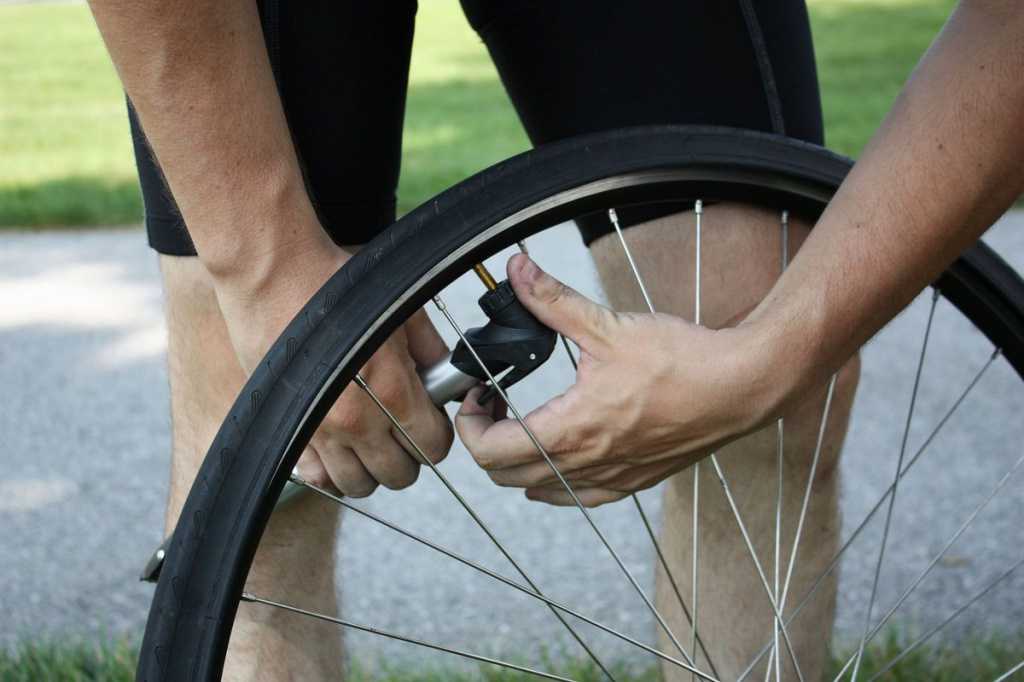 This means that in hot sunny weather, the pressure inside the air chamber will increase without additional pumping. Conversely, on cold winter days, a decrease in tire pressure is quickly felt due to low temperatures. So, when going for a bike ride in the cold season, the pressure indicators need to be adjusted a little higher than usual, and in the summer heat, let the air out a little. It is worth noting that when going on a bike ride, you should always take into account the weather conditions.
This means that in hot sunny weather, the pressure inside the air chamber will increase without additional pumping. Conversely, on cold winter days, a decrease in tire pressure is quickly felt due to low temperatures. So, when going for a bike ride in the cold season, the pressure indicators need to be adjusted a little higher than usual, and in the summer heat, let the air out a little. It is worth noting that when going on a bike ride, you should always take into account the weather conditions.
It is important to consider the load on the bike created by the weight of the rider, especially the fact that most of it is on the rear wheel. Therefore, the degree of its pumping should be slightly higher than the front, the optimal difference is 10%.
To calculate the optimal tire pressure for a bicycle, given the weight of its rider, you can use the table:
Rider weight (kg) Pressure (atmosphere) Pressure (PSI)
The nature, riding style and type of bicycle also affect tire pressure.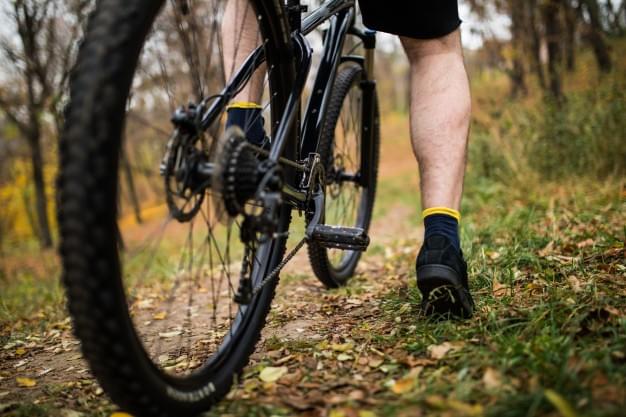 Buyers who prefer an active pastime often opt for mountain bikes with 26-inch wheels, which ride well both on city streets and in rough terrain.
Buyers who prefer an active pastime often opt for mountain bikes with 26-inch wheels, which ride well both on city streets and in rough terrain.
To understand to what pressure to inflate the wheels of a bicycle, it is necessary to take into account the features of both the bike itself and other, at first glance, weightless factors. For example, weaving threads on a tire, rim thickness, driving style. The likelihood of a tire coming off a wide rim is much less than a narrow rim, because a wider rim will hold the tire better than a thin one. Mountain biking already by its name suggests the presence of a difficult surface on the track, with possible obstacles and bumps. The driving style is more aggressive than on a smooth, calm trajectory, it obliges you to increase the tire pressure to a level slightly less than the upper limit.
The diameter of the wheel will also affect the selection of the optimal pressure value, since the larger it is, the higher the volume of air pumped will be.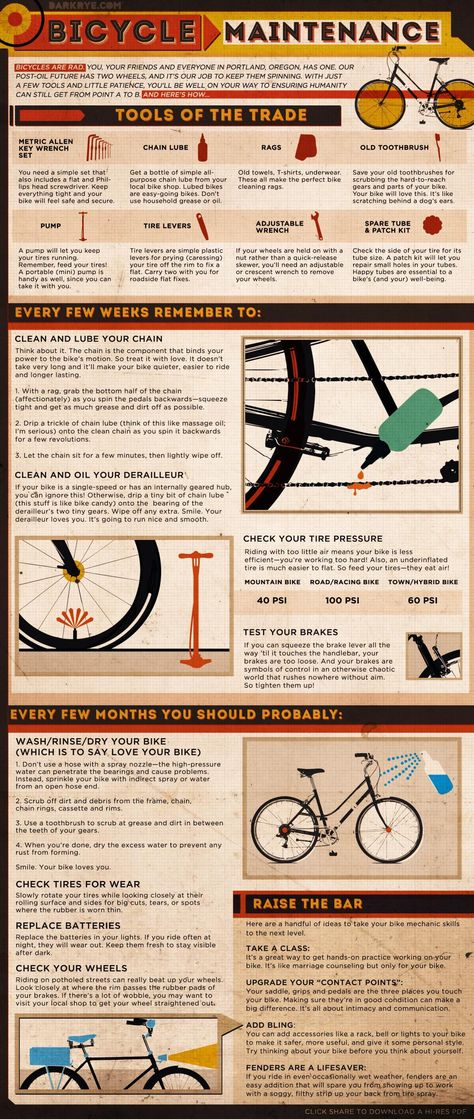 However, for mountain bikes it is not so important whether the wheel diameter is 26 or 29 inches, it is much more necessary to pay attention to the parameters of the rider's weight and the type of track.
However, for mountain bikes it is not so important whether the wheel diameter is 26 or 29 inches, it is much more necessary to pay attention to the parameters of the rider's weight and the type of track.
There are no hard and fast rules about how much you need to inflate the wheels on your bike. There is common sense, experience, practice. Manufacturers can recommend certain values, but only the owner himself will determine exactly which road he will ride, in what weather conditions he will drive, take into account his weight parameters or not. The decision, what pressure in the wheels will be ideal, is sure to be found.
Tire pressure maintenance is one of the most important things in basic bike maintenance and is often overlooked. Meanwhile, maintaining the correct pressure in the bicycle tires will make the ride safe and greatly extend the life of the bicycle components.
1. When riding on underinflated tires, most of the cyclist's energy is spent on overcoming rolling resistance and slowing down.
2. Properly inflated tires will prevent the tire from being pinched by the rim when driving over curbs or railroad crossings.
3. Riding on tires that have sufficient pressure will allow them to be used much longer, eliminating wear and cracks on the sides.
4. Having a tire with the correct pressure protects the wheel rims from warping and denting. All shocks and loads from potholes and objects on the road will be absorbed by the tire.
5. Properly inflated tires also make it easier to steer and control your bike, especially on tight turns.
6. Sufficient pressure will greatly reduce the chance of a puncture.
Even the highest quality cameras lose pressure by about 1 bar per month (1 bar = 0.98692 atmospheres) - this is considered normal. Unlike car tires, bicycle tires have much more pressure and less wall thickness. At higher pressure, its losses increase accordingly. In the normal condition of the chamber and the valve, it is enough to pump up and adjust the pressure in the wheel once a month.
At higher pressure, its losses increase accordingly. In the normal condition of the chamber and the valve, it is enough to pump up and adjust the pressure in the wheel once a month.
It is impossible to give a clear recommendation to what pressure the tires should be inflated. It mainly depends on the total weight of the cyclist and luggage. In the case of a bicycle, a person with things has a weight much greater than the weight of the vehicle on which he rides, i.e., a bicycle.
In addition, each person, especially the experienced one, has his own individual preference for the pressure value. The permissible pressure range is marked by the manufacturer on the tire sidewall. You can deduce the rule: the higher the air pressure, the lower the rolling resistance and the less likely it is to puncture. The lower the pressure, the more comfortable the ride and the better the grip.
Another recommendation to maintain the required pressure in the tires of a bicycle offered by manufacturers: for example, you have derived a certain pressure value for yourself. When carrying luggage, for each additional kilogram it is necessary to increase the pressure by 1%. And the most important rule: in any case, the tire pressure should not be higher or lower than the maximum or minimum value indicated by the manufacturer on the side surface.
When carrying luggage, for each additional kilogram it is necessary to increase the pressure by 1%. And the most important rule: in any case, the tire pressure should not be higher or lower than the maximum or minimum value indicated by the manufacturer on the side surface.
Bicycle chain wear. Ideally, the new chain should be 12.7 times the number of links in the chain. How to know the wear condition of the chain in order to control the situation and change the chain in time, extending the life of the cassette?…
Bicycle preventive lubrication chart. Front and rear derailleurs. The clarity of gear shifting directly depends on their smooth running. Especially the rear derailleur, which moves in three planes. It is also necessary to lubricate the two rollers of the chain tensioner...
How to avoid a puncture. Use a sealant that is poured into the chamber and securely seals the hole when punctured. 500 ml of sealant is enough for two wheels.